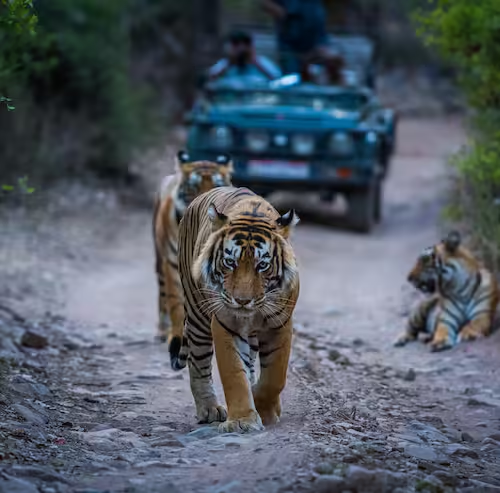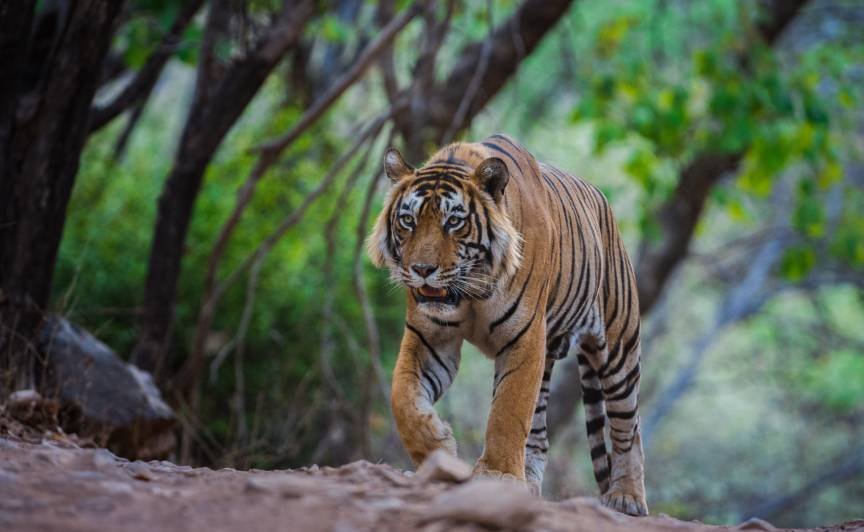
OverView
The jungle safari at Ranthambore National Park happens twice a day, every day, between the months of October and June, and is a popular tourist attraction in Rajasthan. The Ranthambore Wildlife Safari Booking is only permitted during these months and is not available on Wednesdays, as the park remains closed. Ranthambore safari Booking is taken care of by the Backwoods Division, offering two organisations: Jeep Safari and Jog Safari. The Ranthambore jeep safari booking accommodates up to 6 people, while the Canter Safari holds up to 20 people at a time.
Although the Book Ranthambore Jeep Safari option is slightly more expensive than the Canter, it is recommended for those who seek more flexibility and access to areas the Center cannot reach. The safari lasts approximately 3 and a half hours and occurs twice daily: once in the morning and once in the evening. Given its popularity, it’s advisable to book well in advance through the Ranthambore National Park Online Booking system or Ranthambore Online Booking portals. You can also secure seats for the same-day or next-morning safari.
A Brief Insight into Ranthambore Tiger Reserve
 Ranthambore National Park, one of the world’s foremost tiger reserves, shelters the Bengal Tiger and is a top destination for wildlife photographers and enthusiasts. Located in Sawai Madhopur, Rajasthan, the Ranthambore Wildlife Sanctuary has gained worldwide fame as a hub for wildlife tourism in India. Tigers here are unusually active during the day, providing visitors with higher chances of sightings. Ranthambore Tour Packages and Ranthambore Wildlife Tour Packages include safaris that allow close encounters with these majestic creatures. In addition to tigers, you may also spot leopards, hyenas, wild cats, reptiles, and a variety of birds.
Ranthambore National Park, one of the world’s foremost tiger reserves, shelters the Bengal Tiger and is a top destination for wildlife photographers and enthusiasts. Located in Sawai Madhopur, Rajasthan, the Ranthambore Wildlife Sanctuary has gained worldwide fame as a hub for wildlife tourism in India. Tigers here are unusually active during the day, providing visitors with higher chances of sightings. Ranthambore Tour Packages and Ranthambore Wildlife Tour Packages include safaris that allow close encounters with these majestic creatures. In addition to tigers, you may also spot leopards, hyenas, wild cats, reptiles, and a variety of birds.
The park area is separated into center regions and support zones. The core areas, where tigers roam freely, are protected from deforestation and commercial activities. The buffer zones are used by local communities but are still managed for conservation. Ranthambore Tour Itinerary often focuses on zones 1-5, the core tiger areas, with zones 3, 4, and 5 being the most popular for sightings, especially in summer when animals gather near water bodies.
While most of the Ranthambore Safari Zones have water bodies and natural vegetation, Zone 1 to 10 are the most popular place preferred by the tourists to see groups of wild animals busy in their schedules and everyday life in Ranthambore Tiger Reserve. And to visit all these, within a quick few hours, the jeep safari is the safest way to explore this vintage wild heritage and connect to nature. It’s time to travel, relax in the jungle!
Wildlife That Can Be Spotted During Ranthambore Jungle Safari
Ranthambore National Park has a large number of Wild Animals, Reptile Species and birds
Leopard, Caracal, Jungle Cat, Fishing Cat, Desert Fox, Indian Fox, Indian Wild Boar, Palm Civet, Hanuman Langurs, Sambar Deer, Spotted Deer, Indian Gazelle, Black Buck, Blue Bull or Nilgai, Desert Monitor Lizards, Banded Kraits, Cobras, Tortoise, Indian Pythons, Indian Flap Shelled Turtle, Russell’s Viper, Snub Nosed Marsh Crocodiles, Woodpeckers, Greylag Goose, Asian Palm Swift, Dove, Crakes, Sandpipers, Flamingos, Pelicans, Storks, Bulbul, Mynas, Falcons, Parakeets, Cuckoos, Owl, Nightjars
Ranthambore Safari Timing Schedule
| S. No. | Months | Morning | Afternoon |
| 1 | October 1st – October 31st | 6:30 AM – 10:00 AM | 2:30 PM – 6:00 PM |
| 2 | November 1st – January 31st | 7:00 AM – 10:30 AM | 2:00 PM – 5:30 PM |
| 3 | February 1st – March 31st | 6:30 AM – 10:00 AM | 2:30 PM – 6:00 PM |
| 4 | April 1st – May 15th | 6:00 AM – 9:30 AM | 3:00 PM – 6:30 PM |
| 5 | May 15th – June 30th | 6:00 AM – 9:30 AM | 3:30 PM – 7:00 PM |
Best Time for Ranthambore’s Jungle Safari
 The best time to visit is from October to March, but if you’re looking to see tigers up close, plan your visit between April and June when they are near water bodies. Always book your Ranthambore National Park Tour Packages well in advance to secure your desired safari zone, vehicle, and seats. The Ranthambore Safari Cost Per Person can vary depending on your choice of vehicle (Jeep or Canter) and the time of year. Ranthambore Located 130 kms from Jaipur in the Sawai Madhopur district of Southeastern Rajasthan ‘The Ranthambore National Park’ is a major wildlife tourist attraction. With diverse terrain and adequate water bodies, Ranthambore has rich flora & fauna.
The best time to visit is from October to March, but if you’re looking to see tigers up close, plan your visit between April and June when they are near water bodies. Always book your Ranthambore National Park Tour Packages well in advance to secure your desired safari zone, vehicle, and seats. The Ranthambore Safari Cost Per Person can vary depending on your choice of vehicle (Jeep or Canter) and the time of year. Ranthambore Located 130 kms from Jaipur in the Sawai Madhopur district of Southeastern Rajasthan ‘The Ranthambore National Park’ is a major wildlife tourist attraction. With diverse terrain and adequate water bodies, Ranthambore has rich flora & fauna.
Our proficient assistance shall let you have an enigmatic emotion by inhaling the air in an atmosphere shared with the majestic creatures on earth”The Royal Bengal Tigers” amongst the woods of Ranthambore National Park. We provide wildlife safaris in jeeps, canters and gypsy inside multiple eco-tourism zones in Ranthambore.
Dos and Don’ts During the Safari
- Protection: Carry sun hats, scarfs, and masks. The park’s climate is dry, and there can be considerable dust.
- Behaviour: Remain made and quiet. Continuously pay attention to your aide.
- Taking care of: Never feed the creatures. They have adequate food, and taking care of them can be risky given their wild nature.
- Littering: Try not to litter during your safari. All things being equal, discard squander at assigned spots.
- Vehicle Safety: Try not to land from your vehicle and consistently stay situated.
- Noise: Abstain from making clearly commotions or sounds. This could stop creatures and impede sightings.
- Substances: Smoking and liquor utilization are denied inside the recreation area’s premises.
Ranthambore Best Sellers
Travel Information Guide
FAQ's
How do I book Ranthambore Safari Online?
You can book the Ranthambore Safari Online by filling up the form above & selecting your preferences. After you complete filling the form, one of our executives will get in touch with you with all the necessary information & assistance regarding the Ranthambore Safari Booking.
What Documents & Information Required to Book Ranthambore Safari?
To book your Ranthambore Safari online in advance, you will be required to provide the following details:
- ID proof like Aadhaar Card, Voter Id, PAN Card, Driving License (mandatory).
- Date of booking safari & safari timings (morning/afternoon).
- Information about each visitor as printed on the ID Card including full name, sex etc.
- Safari entry fees paid in advance.
- Passport copy is required for International tourists
Are safari bookings refundable?
No refund or cancellation is permitted on confirmed bookings.
How many days in advance can I book the Ranthambore Safari?
You can book your Ranthambore Safari 90 days in advance.
How Many Tiger Safari Zones are there in Ranthambore?
There are 10 safari zones in Ranthambore National Park. Out of these, Zones 1-6 are the best for spotting tigers in Ranthambore National Park.
What are the Jungle Safari Timings in Ranthambore?
The jungle safari timings in Ranthambore are different for the summer and winter season. During the winters, the daylight hours are shorter, while they are longer during the summers. The morning safaris in Ranthambore National Park are conducted from 7:00 AM to 10:30 AM, while the evening safaris are conducted from 2:30 PM to 6:00 PM. The timings may change depending on the particular season.










